|
|
|
 |
| |
MI6 unravels the world of wine with a basic guide for the beginner; as even 007 knows, one never drinks red wine with fish... |
|
Red Wine With Fish?
2nd December 2010
The accomplished secret agent needs an arsenal
greater than brute strength. Knowledge of his beverages has served
James Bond on many a mission. As 'M'
once remarked, "Is there anything you are not an expert
on?" Whilst 007 is
most commonly associated with the Vodka
Martini, his knowledge does not end there. The secret agent
has, in the past expressed an opinion on champagne, wine, brandy,
sake and sherry - to name just a few.
The world of wine, in particular, has been an illusive muddle of tradition, protocol and snobbery. In this guide, we hope to unravel some of the mystery and acquaint the casual reader with varietals, colours, flavours, smells and, most importantly, what you might be able to expect from a wine from its label.
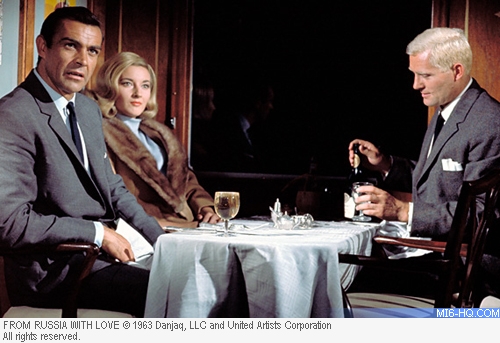
Bond: "Red wine with
fish.
Well, that should have told me something."
|
The first thing to know is that wine and its
traditions are far from similar the world over. The most noticeable
difference is the interchange between varieties (of grape) and
the region in which they are made. For instance, in Europe, most
shop by wine region (Burgundy, Bordeaux, Provence, etc). Meanwhile
in the Pacific (Australia, New Zealand and America) the variety
of grape (Chardonnay, Pinot, Riesling, Merlot, etc) is prominent
on the label.
This does not often add much to your knowledge as the taste is impacted by a combination of grape, soil and weather condition; hence why the year of vintage (when the grapes were grown) impacts the flavour as much, if not more than, the kinds of grapes grown.
Unlike James Bond, readers
will not be able to rattle off vintages amongst friends
within the first month or year or probably decade of your
wine drinking years - most people drink narrowly, meaning,
they try until they find what they like and then choose
the next glass or bottle based on that decision. And, actually,
that is perfectly all right. This article isn't about to
try to make you the most eclectic wine-drinker on the planet,
however if you have no idea where to start, or want to
broaden your tastes it is important that your wine "investment" pays
off. With some minimal knowledge behind you when entering
a restaurant or bottle-shop, readers' chances of selecting
something palatable will be greatly improved. |
|
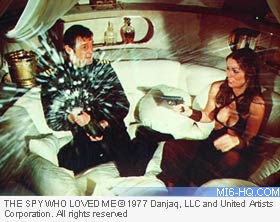
Above: 007 thinks he misjudged Stromberg when he finds Dom Perignon in his escape pod.
|
Think about what you like. What food or drinks are your favourites? Do you have a sweet or savoury palate? Do you prefer tea to coffee? Do you enjoy a rich chocolate dessert or a light lemony sorbet? Wines can be reminiscent of all of these.
Before we go any further, the taste division
is not always a matter of white versus red. Both grapes
(red or green) offer a huge range of flavour. White wine flavours
can range from tangy or grassy to sweet caramel to buttery or oaky.
Reds vary from big bouquets of berries to dry and tannin-rich to
earthy or liquorice. So, avoid ruling out one grape colour based
on one or two negative experiences.
Many spirits survive with age, meanwhile wines age both in the barrel and in the bottle, and this means that one Cabernet Sauvignon from Bordeaux will not be quite like the next. Red wines in particular have a general tendency to get "musty" or "farmyardy" or even "earthy" in the bottle, whilst whites often become "oaky" or even bitter or acidic with age. Hence, a good amount of the snobbery from James Bond's knowledge of wines (and grape derivatives, including port, sherry and champagne) comes from his seemingly nonchalant understanding of which vintages were the preferred ages of the various winemakers.
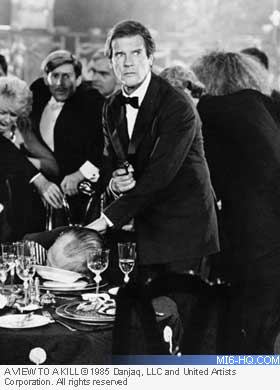
|
|
So, in a nutshell, old wine does not always equate to good wine. Zinfandels and Chianti were made to be drunk the very year they were bottled, whilst others, such as some of the rich reds or Chardonnay often keep successfully (under the right conditions) for anywhere between 5 and 20 years. If the reader was to "take the plunge" and select an older wine from a restaurant menu, be prepared for there to be some - often, dramatic - change to taste, smell and colour to what you were used to when drinking a recently bottled Chardonnay or Merlot.
A fine dining restaurant with an extensive wine list is probably the safest place to try an older wine, as they are more likely to have been aged in the right environment and readers can seek advice from a sommelier (head wine waiter). You will, however, likely to have to purchase the aged wines by the bottle, not by the glass, as the providers cannot guarantee the same wine "experience" with various bottles of the same aged vintage.
Left: An assassin
comes between Bond and his Bordeaux. |
If you wanted to "cellar" some wine yourself, you would need a medium-to-cool, dark place. The important part of cellaring is the constant temperature; some enthusiasts invest in a wine fridge, specifically designed to keep the wine at a constant temperature. Even red wine (traditionally served at "room temperature") can go in such a fridge and can be brought back to room temperature, or chilled as desired, before drinking. For example: under good conditions a Beaujolais could be kept (and improve with age) for up to three years, a Chardonnay for up to five years, a red Zinfandel for up to 10 years and vintage Champagne for up to 10 years.
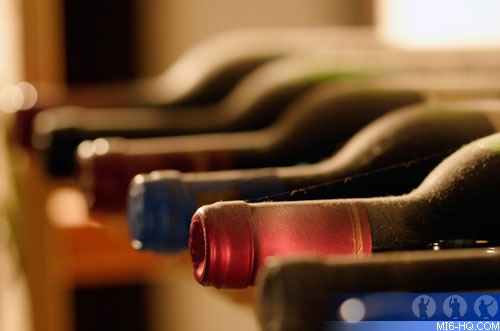
Above: A bricked basement is often the ideal place for preserving wine.
|
As suggested previously,
temperature is important, but it largely turns on a personal
preference. For a guide, consider the table opposite -
yet do not treat it as gospel. For example, many enjoy
some
of
the
richer white wines (Chardonnay and Riesling) unchilled.
Also of note is the convention of comparing room temperature
to chilled wines. The idea of serving reds at room temperature
came about when houses were cooler, around 15° C. Nowadays,
with better insulation and heating, the average home is
in the early 20s. Keep this in mind when reading the table. |
|
Wine temperature guide
- White sparkling wines - 6-10° C
- Red sparkling wines - 10-12° C
- Desert wines - 8-12° C
- Light reds - 10-12° C
- Full-bodied/rich whites - 12-16° C
- Medium reds - 14-16° C
- Full-bodied/rich reds - 15-18° C
|
|
Some wine should be (or is remarkably better) if decanted. This allows the wine to be oxygenated and bring out the full flavour and "nose". If you do not have room in the budget for a decanter, pouring your wine into a glass up to 20 minutes before drinking is often a good substitute.
Champagne is often 007's drink of choice and
for the discerning palate, only Champagne will do. Often the
name champagne is used as a substitute for all sparkling wine,
but
technically "champagne" is only dubbed as such when
it is made from the grapes grown in the Champagne region of France.
All other such sparkling drinks are not privileged with the title.
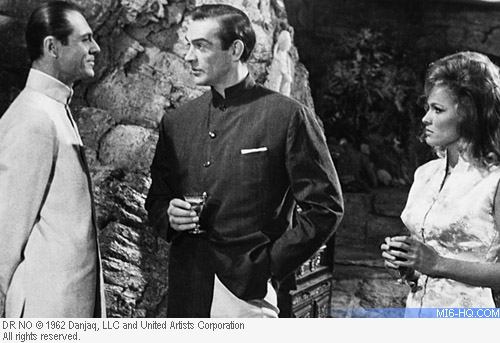
"That's a Dom Perignon '55 - it would be a pity to break it."
...
"I prefer the '53 myself."
|
Interestingly, despite the first grapes for sparkling wine coming from Champagne, it was the British who accepted the product and made it fashionable whilst French winemaking purists rejected early examples of the sparkling wine. Spain, Portugal and the United States of America are also high producers of the sparkling wine.
Dom Perignon is oft quoted by 007 as his pick
amongst Champagnes. Dom Perignon is a product of the famed Moet
et Chandon - its finest single-vineyard production. As well as
quipping with Dr. No over
the vintage of his bubbly in the debut 007 film, Bond splashes
out on two bottles of his favourite on the "Goldfinger" mission,
whilst dining in his suite with Jill
Masterson. Yet, it is not until "Moonraker" that
Bond makes the switch from Dom Perignon to Bollinger.
Other direct references to wines in the James Bond films includes: Kristatos offering
007 Ribolo (a red, Merlot-like wine) from Catalonia but with Bond declining
and selecting Theotaki Aspero (a white); In "A
View To A Kill", 007 orders a dry red Bordeaux, the Lafite Rothschield,
with his main course at the Eiffel tower; Bond swaps the brand on the Harrods
list in "The Living Daylights" to
the Bollinger R.D. (Recently Disgorged) as the brand on the list was "questionable".
And now... the moment you have been waiting for, the varietals themselves.
Barolo
Country: Italy
Colour: Lighter red
Aromas: Chocolate, dried fruit, liquorice, tobacco
Cabernet Franc
Country: France, Italy, Span, Slovenia, USA
Colour: Blue-black
Aromas: Raspberry, grass, capsicum
Cabernet Sauvignon
Country: France, Argentina, Bolivia, Peru, USA, Spain
Colour: Dark red
Aromas: Forrest fruit, plum
Chardonnay
Country: France, USA, Australia, New Zealand, Italy, South Africa
Colour: Green/yellow
Aromas: Butter, hazelnuts, apple, vanilla
Gewürztraminer
Country: Australia, Canada, France, Germany, USA, Israel
Colour: Rosé
Aromas: Rose, spice, citrus
Grenache
Country: Spain, France, Morocco, Australia
Colour: Purple
Aromas: Pepper, smoke, raspberry
Malbec
Country: Argentina, Chile, France, USA
Colour: Purple
Aromas: Tannins, raisin, tobacco, cherry, oak
Merlot
Country: France, Italy, USA, Chile, Mexico, New Zealand, Australia
Colour: Black
Aromas: Cherry, plum, tomato, acidic fruits |
|
Muscat
Country: France, Germany, Portugal, USA, South Africa, Mexico, Spain
Colour: Red
Aromas: Orange, honey, citrus, lime
Pinot gris
Country: Australia, Italy, New Zealand, Ukrane
Colour: Rosé
Aromas: Pear, apple, melon, peach
Pinot noir
Country: Australia, New Zealand, UK, Italy, Germany, Canada
Colour: Black
Aromas: Truffles, cherry, musty (when old), chocolate
Riesling
Country: Germany, Australia, New Zealand, Austria, USA
Colour: Light/Green
Aromas: citrus, peach, honey
Sauvignon blanc
Country: France, Australia, Chile, Brazil, USA, South Africa
Colour: Light/green
Aromas: cut grass, lime, capsicum, grapefruit, guava
Syrah
Country: France, Australia, South Africa, USA, Chille
Colour: Black
Aromas: Pepper, smoke, blackberry
Zinfandel (red)
Country: Croatia, USA, Italy, Mexico, Australia, Dalmatia
Colour: Red
Aromas: Honey, sweet berry, mint |
The above is by no means a complete list, but a few of the common varieties, so next time you browse the shelves, you might be a little less daunted by your choice.
|
|
|